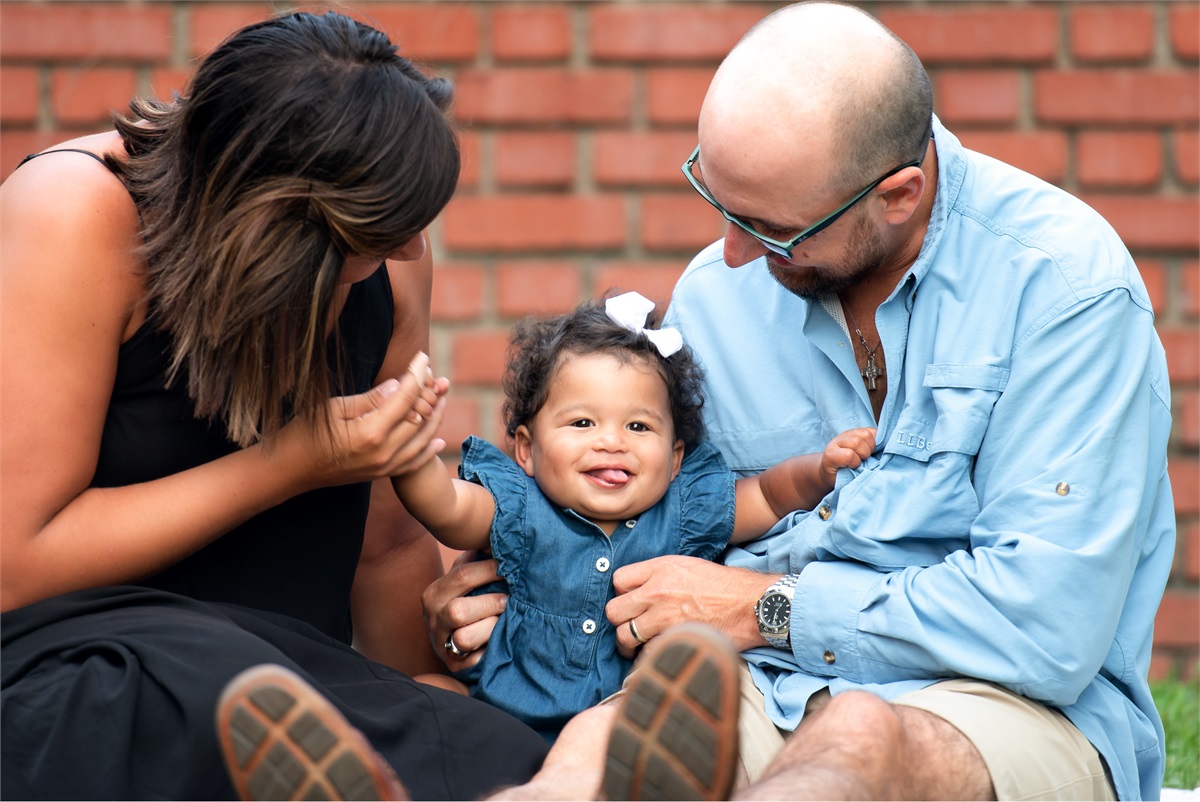Congress has passed the SECURE Act as part of the Federal government spending bill and the President has signed it into law as of December 20th 2019, with most provisions going into effect January 1st 2020. There are many changes that affect retirement accounts with the passage of legislation, but I want to share how this affects parents that are planning to adopt.
My wife Amanda and I are the proud adoptive parents of our daughter, Abigail, who at the time of writing is 19 months old. Our adoption journey, like many others, was long journey with many unexpected twists and turns that challenged us and strengthened us. It took over three years and several failed adoptions for God to bring the right child to us. We were blessed to receive Abby at birth, but we did not finalize her adoption for another 10 months and it was a hard-fought legal battle. Having gone through this experience, we have learned a lot about the adoption process and the challenges this process may present to prospective parents.
One of the many challenges of adopting are the costs and the complexity of understanding options on how to pay for these costs. With the passage of the SECURE Act, starting January 1st, 2020 adoptive parents have an additional funding tool to help with their adoptions. With this passage, adoptive parents can now withdraw up to $5,000 from their retirement funds, prior to age 59 ½, without incurring the 10% early withdraw penalty! This new provision is being commonly referred to as the “Adoption Distribution”.
Section 113 of the SECURE Act addressed the change regarding the Adoption Distribution. A summary of Section 113 is:
- An exception to the 10% early distribution penalty.
- Allows up to $5,000 to be distributed penalty-free from an IRA or from a retirement plan as a “Qualified Birth or Adoption Distribution”.
- To meet the requirements of a Qualified Birth or Adoption Distribution, an individual must take a distribution from their retirement account at any point during the one-year period beginning on either the date of birth, or the date on which the adoption of an individual under the age of 18 is finalized.
- A key point here is that an Adoption Distribution will only be able to provide financial assistance once the qualifying event has occurred. This means that the account owners can’t take such a distribution to pay for initial adoption expenses prior to the date the adoption is finalized.
- An adoptive parent choosing to use this as part of their funding sources will need to come up with these resources to pay for these costs. However, some adoption costs may not be due until after the finalization (for example a final legal bill) which may make this option useful for those expenses.
- The new rules do not require that the distribution directly tie to qualifying expenses, only that the distribution occurs after a qualifying event so this could be used for other expenses incurred during adoption.
- The $5,000 limit applies to each individual, therefore in the case that there are two adoptive parents each with their own retirement assets, each can make the Adoption Distribution up to $5,000 for each child adopted.
- The $5,000 limit applies to each adoption so an additional $5,000 limit would apply if you adopt another child in the future.
- There is a provision that gives opportunity to replenish these funds back into the respective individual’s retirement accounts. This would be over and above the standing contribution limits to act as a “repayment” to themselves.
- As of the writing of this post, the IRS has not clarified timing rules for this “replenishment” option.
Is the Adoption Distribution right for me?
I was excited to see congress add this provision to the SECURE Act. In my opinion, it was a small way that Congress was recognizing the important role that adoption plays our society and helping to encourage members of society to consider adoption. However, it is important to understand the limitations of this Adoption Distribution to decide if this may be a good option for you if you are adopting.
Here are the key drawbacks of the adoption distribution you should consider before using this option:
- First, not having the ability to access this money without a penalty prior to the finalization of the adoption will force the parent(s) to find access to funds prior to the adoption finalization which can take a long time. For us it was 10 months after our daughter was born and in our custody.
- Second, the parent(s) that uses the Adoption Distribution is taking money from their long-term retirement savings. They are losing the long-term compounding potential of these funds for their retirement and possibly losing the long-term tax-deferred growth advantage of these funds.
Where this can be a viable option for a parent(s) are:
- You have exhausted all other funding options and need additional money to make your dream come true.
- You have additional bills due after the adoption date and no other resources to pay those bills.
- You want to use this as a short-term bridge to pay for additional expenses and use tax credit to “replenish” your retirement account
- This would have additional challenges including but not limited to:
- If in a market-based investment this could be time out of the market and adversely effect returns
- Congress could change requirements or remove tax credit at any time and possibly not get this credit by the time you complete your taxes
- Additional costs could come up and you do not “replenish” the funds from your retirement accounts
- IRS creates timing requirements for “replenishment” of these funds, and you may not be able to replace the distribution
- This would have additional challenges including but not limited to:
If you are planning on adoption you should understand common adoption costs. It is important to remember that each adoption is a unique set of circumstances and costs can vary widely. We believe it’s important to look at your unique circumstances and situation to plan what your costs may be and elevate those costs in your personalized financial plan.
The basic costs associated with adoption
To understand the basics of the costs associated with adoption it’s important to understand the three main areas of adoption available to parents in the United States; foster care, domestic, and foreign.
- Foster Care
- Adoption through foster care can vary a lot by state and by situation. Typically, as a foster parent a lot of the costs are picked up by the state including the home study, training, counseling and legal costs. Foster care is a temporary option but can lead to adoption in certain circumstances.
- Domestic
- Domestic adoption is adopting a child from a birth parent in the United States. This can be done through an agency or with the help of a qualified adoption attorney. The costs vary greatly but typically range between $15,000 – $85,000.
- Foreign
- Foreign adoption is adoption a child from a foreign country. This requires an agency and has restrictions and costs associated with the country of origin. Some countries may require multiple trips and longer stays that can add up. Including travel, the costs are typically $30,000 – $100,000.
Looking at the cost components:
- Home study
- Required by state to be able to adopt, costs vary by agency that is doing the study but typically range from $3,000-$5,000. If you are using an agency for your placement, you may want to check if they require you to use their home study, so you do not incur this cost twice. This is required for all forms of adoption but in the case of foster care, these costs are typically picked up by the state.
- Legal
- These are the legal costs associated with adoption and include preparing for the finalization of adoption, fighting any legal battles with birth family members, detective services when parents cannot be found finalization of the adoption to mention the most common. These costs will typically range from $5,000-$20,000 based on the services required, situation and legal counsel’s costs. These legal fees are typically picked up by the state for Foster care.
- Agency
- An agency can help connect birth parents and adoptive parents, provide counseling to birth parents and adoptive parents, and help birth parents and adoptive parents navigate the process. These fees can range between states and agencies but typically range from $10,000-$35,000.
- Birth Parent support
- These are costs associated with supporting the birth mother during the adoption process. These can include medical bills, housing costs, food allowance and general spending allowance. Some states do not allow this, and some states even require this. These can typically range from $250-$2,500 a month for up to 10 months.
- Travel
- These are the costs associated with traveling to meet birth parent and/or to receive your child. They can be basic travel in your area, out of state travel and international based on the type of adoption you choose. They can range from $500-$30,000 depending on the frequency and type of travel.
- Child basics
- To receive your child depending on age you will be required to have or need the basics including a new car seat, diapers, formula, bottles, bathtub, burp clothes, baby wipes, an infant thermometer, clothes, a bassinet, and a changing station. You will need more as the child grows but these are the basics to get your child home. This will range from $100-$500 depending on how much you are able to get from others or deals you find.
- Medical Bills
- If the child is born with health issues, there can be substantial medical costs.
Key considerations to evaluate when trying to determine your costs
- Location
- The state the child is born in or country they are born in will play a big role in costs.
- Agency or private adoption
- What services your agency provides
- Counseling
- Matching services (helping find birth parents)
- The child’s situation
- This can include an unknown birth father or mother that has not received proper counseling prior to making this important decision.
Understanding common adoption funding solutions
- Grants
- There are many foundations that provide grants to prospective parents. A recent Google search for adoption grants yielded over 40 million results. This does not mean there are 40 million grants, but it shows there is a lot of information and a lot of different grants available. Few common ones are:
- A Child Waits Foundation:This organization awards grants for adopting to families who are in the international or domestic adoption process. The maximum grant amount (in most cases) is $7,000.
- Gifts of Adoption Fund:Founded by adoptive parents who experienced how prohibitive the cost of adoption can be, this organization award grants for adoption fees to families adopting domestically and internationally.
- Help Us Adopt:The adoption assistance grants awarded by Help Us Adopt can be up to $15,000, which is higher than most organizations.
- National Adoption Foundation:Families adopting through any process can apply for a grant from the National Adoption Foundation. That means they award domestic adoption grants as well as international. They require applicants to have a completed home study or be in the process of completing the home study.
- Loans
- There are many financial institutions that offer these types of loans and the rates will very based on the credit worthiness, financial situation of the borrowers, loan term and amounts.
- Fundraising
- Some couples will turn to fundraising efforts such as a car wash, bake sale or others. Also, this can include using social funding platforms such as gofundme.com.
- Tax Credit
- You can claim the credit if you adopted from foster care, adopted internationally, adopted a relative’s child, or adopted privately from US (except your spouse’s child) and At the time of adoption, the child was under 18 (or physically or mentally unable to take care of him or herself).
- If you were adopting from the US, you can also claim the credit for expenses for a failed or non-finalized adoption, although you need to wait until a year after you incur the expenses.
- For 2019 adoptions (claimed in early 2020), the maximum adoption credit and exclusion is $14,080 per child. The credit will begin to phase out for families with modified adjusted gross incomes above $211,160 and the credit will go away completely for those with incomes around $251,160.
- Key points are current law could go away at any time and it only is applied after adoption is finalized.
- You can claim the credit if you adopted from foster care, adopted internationally, adopted a relative’s child, or adopted privately from US (except your spouse’s child) and At the time of adoption, the child was under 18 (or physically or mentally unable to take care of him or herself).
- Company funding
- Companies may provide adoption assistance to help cover the costs of adoptions including fees, court costs, attorney fees, travel expenses and other necessary expenses. These programs can be income tax free (still subject to Social Security, Medicare and federal unemployment taxes) benefits if structured correctly and can be up to the full amount of the costs. These programs are increasing in popularity over the past years as unemployment has been low and employers are looking to increase fringe benefits to attract and retain talent.
- Many large companies including Wendy’s, American Express, PWC, Best Buy, PNC Bank, Citizens Bank, Netflix, and Etsy to name a few, and small companies provide this benefit.
- At Beratung Advisors we offer to provide $2,000 towards qualified adoption expenses for our associates.
- Second job / side gigs
- Some couples choose to work second jobs and side gigs. Some common examples are ride sharing such as Uber or Lyft and part time jobs that allow them to work through days off or hours they are not working at their current employers.
- Companies may provide adoption assistance to help cover the costs of adoptions including fees, court costs, attorney fees, travel expenses and other necessary expenses. These programs can be income tax free (still subject to Social Security, Medicare and federal unemployment taxes) benefits if structured correctly and can be up to the full amount of the costs. These programs are increasing in popularity over the past years as unemployment has been low and employers are looking to increase fringe benefits to attract and retain talent.
- There are many foundations that provide grants to prospective parents. A recent Google search for adoption grants yielded over 40 million results. This does not mean there are 40 million grants, but it shows there is a lot of information and a lot of different grants available. Few common ones are:
How do I navigate adoption?
Adoption can be complicated, but there is good news if you are exploring adoption. There are lot of resources to help you in your journey. At Beratung Advisors, one of our core values is Teamwork, and we believe this applies to adoption.
You will want to have a team to help you discern if adoption is the right choice for you. We recommend:
- Partnering with an agency you trust to help you navigate these options
- Engaging an attorney that specializes in adoptions
- CPA to help you determine your tax ramifications
- Working with a financial planner to determine the costs and how to meet your goals
Costs are just one of the many areas of adoption you will need to explore before making this decision but it is an important factor. We believe that having a financial planner that you trust helping you make adoption part of your personalized comprehensive financial plan is an important part of this teamwork.
If you are planning on adopting and are looking for a firm to educate and empower you, we can help give you guidance with a plan, call us today at 412-357-2002.
If you have found this information useful, please share it with others that can use this information. Share your adoption experience in the comments on our Facebook page or on my LinkedIn.
This is meant for educational purposes only. The information is based on data gathered from what we believe are reliable sources. It should not be considered investment advice, nor does it constitute a recommendation to take a particular course of action. Please consult with your financial professionals regarding your personal situation prior to making any financial related decisions. This information is not intended to be a substitute for specific individualized tax or legal advice. We suggest that you discuss your specific situation with a qualified tax or legal advisor. Traditional IRA withdrawals are taxed as ordinary income and may be subject to a 10% federal tax penalty if withdrawn prior to age 59 1/2. Roth IRA earnings withdrawn prior to the end of the Roth IRA five-year aging period and prior to reaching age 59½ will be subject to a 10% early withdrawal penalty unless used to meet qualified expenses. 03/20

eMoney 103: Data Input – Asset Allocation
In the ninth class of eMoney Masterclass 103 our CEO Greg Furer reviews how to input savings, contributions and withdraws into your client’s financial plan.

eMoney 103: Data Input – Savings, Contributions and Withdrawals
In the ninth class of eMoney Masterclass 103 our CEO Greg Furer reviews how to input savings, contributions and withdraws into your client’s financial plan.








